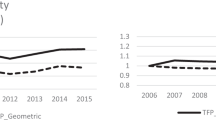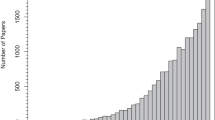Abstract
This paper critically discusses the most common methodology for decomposing productivity change into inter- and intra-firm effects. It is argued that the methodology can be improved to explicitly take the role of structural transformation into account, and by so doing, a potential source of bias in the results is corrected. This requires the use of a tool from the field of theoretical evolutionary biology: Price’s equation. A review of a sample of studies that apply decomposition analyses shows that the methodology is best suited for studies of the evolution of labour productivity and the reallocation of labour. Based on Danish data for 1992–2010, it is then demonstrated how the results of decomposition analyses can be considerably improved by the explicit inclusion of levels in the selection process. In the specific analysis conducted by the current paper, economic selection among industries is included. It is found that the structural transformation of the economy has a large impact on the results of decomposition studies, not least on the magnitude of the inter-firm selection effect. Structural transformation from capital-intensive and thus high-labour-productivity manufacturing towards labour-intensive and thus low-labour-productivity services entails that the traditional methodology is biased downwards in its measure of economic selection. Finally, it is demonstrated that the length of the interval studied, while often determined by data limitations, has a significant but predictable effect on the results, and it is tentatively demonstrated that economic selection tends to be stronger in the trough of the business cycle.





Similar content being viewed by others
Notes
Potentials for widening the definition of evolution when using Price’s equation are discussed in Andersen and Holm (2014).
A process of this nature is, for example, seen in the manufacturing of computers, where the consumer price index shows 80 % deflation in Denmark for the 2000–2013 period.
Schumpeter (1947), pp. 84–85 argued that reallocation of market shares through price cutting is as effective relative to innovation, as “forcing a door” is effective relative to “a bombardment”. Thus, the evolution of the economic system is comparatively indifferent to whether price competition functions. The results of Coad and Teruel (2013) show that changes in the total size of a market far outweigh the effect of competitors’ growth on any given firm.
The use of pre- and post-evolution is not intended to signal that evolution starts and stops. It is intended to distinguish between the population before and after the change in the mean characteristic.
Original Danish name: Firma- og Ressourceområdestatistik.
Danish: General Erhvervsstatistik.
Available from www.statistikbanken.dk
The results reported in the paper all rely on four-digit codes. Results for two- and three-digit codes are available upon request.
References
Andersen ES (2004) Population thinking, Price’s equation and the analysis of economic evolution. Evol Inst Econ Rev 1(1):127–148
Andersen ES, Holm JR (2014) The signs of change in economic evolution: An analysis of directional, stabilizing and diversifying selection based on Price’s equation. J Evol Econ 24(2):291–316
Baldwin JR (1995) The dynamics of industrial competition. Cambridge University Press, Cambridge
Baldwin JR, Gu W (2006a) Competition, firm turnover and productivity growth. Statistics Canada, Economic Analysis Research Papers 11F0027MIE No. 042
Baldwin JR, Gu W (2006b) Plant turnover and productivity growth in Canadian manufacturing. Ind Corp Chang 15(3):417–465
Bartelsman EJ, Doms M (2000) Understanding productivity growth: lessons from longitudinal microdata. J Econ Lit 38(3):569–594
Bartelsman EJ, Bassanini A, Haltiwanger J, Jarmin RS, Schank T (2004) The spread of ICT and productivity growth: Is Europe lagging behind in the New Economy? In: Cohen D, Garibaldi P, Scarpetta S (eds) The ICT Revolution: Productivity Differences and the Digital Divide. Oxford University Press, Oxford and New York, pp 1–140
Bottazzi G, Dosi G, Jacoby N, Secchi A, Tamagni F (2010) Corporate performance and market selection: Some comparative evidence. Ind Corp Chang 19(6):1953–1996
Cantner U, Krüger JJ (2008) Micro-heterogeneity and aggregate productivity development in the German manufacturing sector. J Evol Econ 18(2):119–133
Caves RE (1998) Industrial organisation and new findings on the turnover and mobility of firms. J Econ Lit 36(4):1947–1982
Coad A (2007) Testing the principle of ‘growth of the fitter’: The relationship between profits and firm growth. Struct Chang Econ Dyn 18(3):370–386
Coad A, Teruel M (2013) Inter-firm rivalry and firm growth: is there any evidence of direct competition between firms Ind Corp Chang 22(2):397–425
Disney R, Haskel J, Heden Y (2003) Restructuring and productivity growth in UK manufacturing. Econ J 113(489):666–694
Dosi G (2007) Statistical regularities in the evolution of industries: a guide through some evidence and challenges for the theory. In: Malerba F, Brusoni S (eds) Perspectives on Innovation. Cambridge University Press, Cambridge, pp 153–186
Dosi G, Nelson RR (2010) Technical change and industrial dynamics as evolutionary processes. In: Hall B H, Rosenberg N (eds) Handbook of the Economics of Innovation, vol 1. Elsevier, Amsterdam, pp 51–127
Endler JA (1986) Natural Selection in the Wild. Princeton University Press, Princeton
Foster L, Haltiwanger J, Krizan CJ (1998) Aggregate productivity growth: Lessons from microeconomic evidence. NBER Working Paper Series:6803
Foster L, Haltiwanger J, Krizan CJ (2002) The link between aggregate and micro productivity growth: Evidence from retail trade. NBER Working Paper Series 9120
Foster L, Haltiwanger J, Syverson C (2008) Reallocation, firm turnover, and efficiency: Selection on productivity or profitability Am Econ Rev 98(1):394–425
Frank SA (1995) George Price’s contribution to evolutionary genetics. J Theor Biol 175(3):373–388
Jovanovic B (1982) Selection and the evolution of industry. Econometrica 50(3):649–670
Krüger JJ (2008) The sources of aggregate productivity growth: US manufacturing industries, 1958-1996. Bull Econ Res 60(4):405–427
Mascarenhas B, Aaker DA (1989) Strategy over the business cycle. Strat Manag J 10(3):199–210
Metcalfe JS (1994) Competition, Fisher’s principle and increasing returns i the selection process. J Evol Econ 4(4):327–346
Metcalfe JS (1998) Evolutionary Economics and Creative Destruction. Routledge, London and New York
Metcalfe JS (2008) Accounting for economic evolution: Fitness and the population method. J Bioecon 10(1):23–49
Morris DW, Lundberg P (2011) Pillars of Evolution: Fundamental Principles of the Eco-Evolutionary Process. Oxford University Press, Oxford
Navarro P (2005) The well-timed strategy: Managing the business cycle. Calif Manag Rev 48(1):71–91
Navarro P, Bromiley P, Sottile P (2010) Business cycle management and firm performance: Tying the empirical knot. J Strateg Manag 3(1):50–71
Nelson RR, Winter SG (1982) An Evolutionary Theory of Economic Change. Harvard University Press, Cambridge MA and London
Price GR (1970) Selection and covariance. Nature 227:520–521
Price GR (1995) The nature of selection. J Theor Biol 175(3):389–396
Rice SH (2004) Evolutionary Theory: Mathematical and Conceptual Foundations. Sinauer Associates, Inc. Publishers, Sunderland
Schumpeter JA (1947) Capitalism, Socialism and Democracy, 2nd edn. Harper & Brothers, New York and London
Silverberg G (1988) Modelling economic dynamics and technical change: Mathematical approaches to self-organisation and evolution. In: Dosi G, Freeman C, Nelson R R, Silverberg G, Soete L (eds) Technical Change and Economic Theory. Pinter, London and New York, pp 531–559
Sørensen JB (2004) Recruitment-based competition between industries: a community ecology. Ind Corp Chang 13(1):149–170
Sutton J (2007) Market share dynamics and the “persistence of leadership” debate. Am Econ Rev 97(1):222–241
Syverson C (2011) What determines productivity J Econ Lit 49(2):326–365
Windrum P (2007) Neo-Schumpeterian simulation models. In: Hanusch H, Pyka A (eds) Elgar Companion to Neo-Schumpeterian Economics. Edward Elgar, Cheltenham and Northampton, pp 405–439
Acknowledgements
This paper is partially based on a chapter from my PhD thesis from 2011, and I am grateful to my supervisors: Esben Sloth Andersen and Christian Richter Østergaard, and to my evaluation committee: Jan Fagerberg, Luigi Marengo and Bart Verspagen for their constructive feedback. I am also indebted to the participants of the 1st IWH ENIC Workshop in Halle, July 2013, to Alex Coad and to two anonymous reviewers for their constructive feedback on the current version. Any remaining errors are entirely my own.
Author information
Authors and Affiliations
Corresponding author
Appendix tables:
Appendix tables:
Rights and permissions
About this article
Cite this article
Holm, J.R. The significance of structural transformation to productivity growth. J Evol Econ 24, 1009–1036 (2014). https://doi.org/10.1007/s00191-014-0380-6
Published:
Issue Date:
DOI: https://doi.org/10.1007/s00191-014-0380-6




